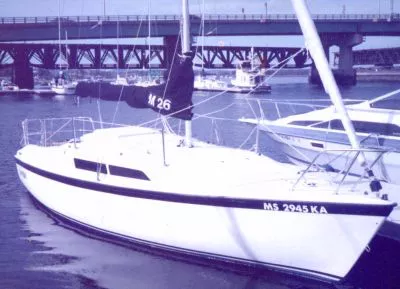Content Overview
Differences in MacGregor 26 Models
There is some confusion regarding the various MacGregor 26 models and their sailing capabilities. The MacGregor 26 evolved from the Venture 22 and the MacGregor 25, which were produced from 1973 until about 1987. The M25 had a weighted centerboard keel, similar to other trailerable sailboats, and boasted positive flotation, an affordable price, easy trailering, and a comfortable interior including an enclosed head (porta-potty). These features were retained in the M26 models, contributing to MacGregor’s status as one of the best-selling sailboats.
- The MacGregor 26D (daggerboard), produced from approximately 1986 to 1990, incorporated water ballast to replace the weighted keel. When drained for trailering, the boat weighed only 1,650 lbs, making it more appealing to tow with a standard automobile. The daggerboard, similar to a keel, helps prevent sideways drift but can be lifted for shallow waters and trailering.
- The MacGregor 26S, manufactured from 1990 to 1995, replaced the daggerboard with a swing centerboard that kicks up in the event of grounding and made various smaller adjustments. Both the 26D and 26S are often referred to as the “classic” MacGregor 26, or sometimes the 26C. Owners of these earlier models frequently regard them as “the real sailboats” before the updates introduced with the MacGregor 26X.
- The MacGregor 26X, built from 1996 to 2004, marked a significant departure from earlier “classic” M26 models by allowing a considerably larger outboard engine, effectively converting the 26X into a powerboat with a mast. Earlier iterations generally handled outboards of 5 to 10 HP, but the 26X could now accommodate up to 50 HP. Notably, many 36-foot sailboats from this era, weighing more than five times the M’s weight, operated with inboard engines of 25-30 HP. The water ballast could be drained for power, enabling the M26X to plane like a speedboat. The outboard well was relocated to the centerline, twin rudders were added, and the steering system transitioned from a tiller to a powerboat-style steering wheel. The cabin height was increased for more space, and sailing capabilities were reported to be less favorable than the earlier 26 models.
- The MacGregor 26M (motorsailor), from 2005 to present, continued the trend of the 26X, now supporting an outboard of up to 60 HP. The swing centerboard was replaced with a daggerboard to optimize space below deck, and an additional tier of windows was included, providing standing headroom. This model is marketed to achieve speeds of 24 MPH. In addition to the water ballast, there’s 300 lbs of permanent ballast, likely necessary for stability given the considerable windage and the heavy engine weight. At a dry weight of 2,550 lbs (excluding engine), it now requires a stronger vehicle and towing package.
Risks and Precautions
Many traditional sailors often joke about MacGregors due to their lightweight fiberglass construction (the hull may exhibit “oilcan” flex under pressure) and their powerboat features since 1996. Critics argue that it does not represent a “real sailboat.” The water ballast, a hallmark of all twenty-six models, is often misunderstood.
Importantly, the water ballast tank is oriented horizontally and situated just a foot beneath the surface, unlike a typical vertical ballasted keel or centerboard that extends much deeper. Some have questioned the classification of water as ballast since its weight matches the water displaced by the boat; however, the ballast tank is engineered effectively and provides righting moment akin to a keel when the boat heels over because of the weight of water displaced far out from the centerline on the “uphill” side. This dynamic does contribute to the boat feeling more tender or tippy initially.
Anecdotes exist, such as the account of a sailor on one edge of the deck grabbing the mast as the boat heeled, inadvertently causing the boat to capsize completely. While the validity of this story is debatable, it highlights the common perception surrounding the MacGregor’s tenderness.
Tragically, one incident involved an M26 capsizing with 10 people aboard, resulting in two fatalities. This unfortunate event was likely due to an uneven distribution of weight among those on the vessel.
Safely Sail the Water-Ballast
In typical sailing conditions, careful sailors can operate the water-ballast M26 safely by adhering to standard safety precautions:
- Reef sails when winds are strong.
- Maintain balance with crew weight strategically distributed against heeling.
- Prevent accidental gybes.
- Ensure the ballast tank is full and properly sealed.
- Keep steerage control intact at all times.
- Heave to or implement other storm strategies in adverse weather.
- Avoid alcohol consumption while sailing.
Furthermore, it is crucial to recognize that for many owners, the M26 serves as a “starter boat,” and they may lack the requisite experience or knowledge to preemptively avoid potential issues. Ultimately, anyone engaging in sailing must be acutely aware of their boat’s limitations and diligently follow all safety protocols.
Experience With the MacGregor 26S
Based on personal experience owning and sailing the 26S extensively for three years, it indeed performs well and lives up to its reputation as a spacious and easily trailerable pocket cruiser. This sailboat caters to a variety of budgetary constraints and provides sufficient space for a family of three to comfortably cruise for up to a week.
Despite its lightweight design, experienced sailors can successfully navigate winds of up to thirty knots with appropriate caution. While the fiberglass construction is thin, navigating around rocks can be easily managed. Numerous MacGregor owners have shared positive experiences related to their sailing adventures.
Importantly, always remember that it’s a lightweight boat, and precautions must be taken as listed above. For those transitioning from powerboat ownership with the 26X and 26M, this vessel is comparably safe; however, collisions with rocks or other boats at 24 MPH should be avoided to ensure safety.





